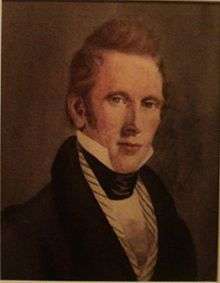James Howard Scott
| James Howard Scott | |
|---|---|
 Painting of Scott, inside the First Toronto Post Office. | |
| Postmaster for Town of York, later was the first postmaster in the newly formed City of Toronto | |
|
In office July 2, 1828 – December 13, 1837 | |
| Monarch | George IV of the United Kingdom, William IV of the United Kingdom |
James Howard Scott was a public servant in Canada West. He served as postmaster in the Town of York and later was the first postmaster in the newly formed City of Toronto. He would later lose his position during the Upper Canada Rebellion in 1837.
Biography
Scott was born on September 2, 1798 in Bandon, County Cork in the Republic of Ireland, the son of John Howard and Mary Scot. He left Ireland in 1819 and briefly settled in Fredericton, New Brunswick where he married, before moving to York in 1820. Shortly after arriving in York, he was appointed to the staff of the First Toronto Post Office, where he worked under William Allan. On July 2, 1828, he succeeded Allan as postmaster of the Town of York,[1] a “plum position” in a colonial capital. His annual salary in the position of Postmaster was 713 pounds. He reported to Thomas Stayner, the Deputy Postmaster General for British North America stationed in Quebec City. The postmaster of York was the unofficial Deputy Postmaster General for Upper Canada, the most important postal official in the colony. To the residents of York, being a British and very Anglican town, having an Irish Methodist in this position caused him to be viewed with wariness by some. Howard moved his family north to an area close to Yonge St and St. Clair Avenue. The move freed up his former living space in the post office, allowing it to expand. He would commute to the post office on horseback.[2]
During this busy time, Stayner offered Howard the newly created position of Post Office Surveyor of Upper Canada. Having recently relocated his family and happy with his job in Toronto, he declined the position (Charles Albert Berczy would accept the position). This decision would have “dire consequences” for Howard in the future.[2] Amid the tension surrounding the Rebellion and growing suspicious, Howard wrote to Berczy asking for an investigation on December 9, 1837. He was “assured that there was nothing against him except that he had associated too much with “those people” (the rebels); however, he was removed from his post by Lieutenant Governor Francis Bond Head on December 13, 1837, much to his surprise. Howard would learn from Thomas Stayner in January 1838 that Governor Head suspected him “of compliance with the aims and plans of the rebels” because of prior contact he had with John and Joseph Lesslie and that fact that he mostly appointed revolutionary party sympathizers to the Toronto post office. Howard did not take up arms against the rebels, further reinforcing Head’s doubts about him. Howard tried to answer the accusations against him by stressing his political neutrality and explaining that as postmaster he had never voted nor attended a political meeting. He was never asked to leave his post and take up arms. Despite this, Head wanted a “zealously loyal man” in charge of the post office and he was unable to understand nor tolerate Howard’s neutrality.[1] Howard also refused to open mail of suspected rebels before the 1837 uprising, further infuriating his superiors.[2]
Howard’s case was brought before Lord Glenelg, the colonial secretary in February 1838. Glenelg consulted both Bond Head and his successor, George Arthur; Head stood firm in his position; though Arthur agreed, he did obtain a report from the Executive Council in May 1838, signed by Robert Baldwin Sullivan, Allan, and Augustus Baldwin. Although supporting Howard’s political neutrality, it upheld Head’s action to dismiss Howard. Lord Glenelg chose not to act and would let the matter rest.[1] During the Rebellion, William Lyon Mackenzie entered Howard’s house, harassed his wife, and commandeered provisions for the rebel troops.[1]
Howard was granted a coat of arms on January 23, 1857, bearing the motto “PRO FIDE” by Letters Patent.[3]
Howard died on March 1, 1866 in Toronto, Canada West.[1]
References
- 1 2 3 4 5 Marion Beyea (1976, online version 2016). "HOWARD, JAMES SCOTT". Dictionary of Canadian Biography. University of Toronto/Université Laval. Retrieved June 23, 2016. Check date values in:
|date=(help) - 1 2 3 James Scott Howard, Postmaster of Toronto (Plaque inside museum). First Toronto Post Office: Town of York Historical Society.
- ↑ "James Scott HOWARD, Toronto, Canada West, Registration of Arms, January 15, 2015, Vol. VI, p. 477". Governor General of Canada. January 15, 2015. Retrieved June 23, 2016.